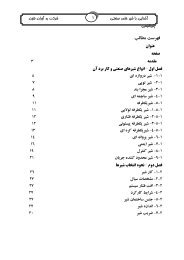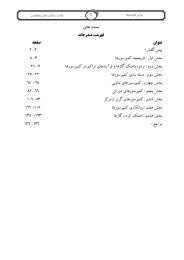Chapter 14 MASS TRANSFER
Chapter 14 MASS TRANSFER
Chapter 14 MASS TRANSFER
You also want an ePaper? Increase the reach of your titles
YUMPU automatically turns print PDFs into web optimized ePapers that Google loves.
<strong>Chapter</strong> <strong>14</strong> Mass Transfer<strong>14</strong>-20 The binary diffusion coefficients of CO 2 in air at various temperatures and pressures are to bedetermined.Assumptions The mixture is sufficiently dilute so that the diffusion coefficient is independent of mixturecomposition.Properties The binary diffusion coefficients of CO 2 in air at 1 atm pressure are given in Table <strong>14</strong>-1 to be0.74 10 5, 2.63 10 5, and 5.37 10 5m 2 /s at temperatures of 200 K, 400 K, and 600 K, respectively.Analysis Noting that the binary diffusion coefficients of gases are inversely proportional to pressure, thediffusion coefficients at given pressures are determined fromD ( T, P) D ( T, 1 atm) / PABwhere P is in atm.(a) At 200 K and 1 atm:ABD AB (200 K, 1 atm) = 0.7410 -5 m 2 /s (since P = 1 atm).(b) At 400 K and 0.8 atm: D AB (400 K, 0.8 atm)=D AB (400 K, 1 atm)/0.8=(2.63 10 5 )/0.8 = 3.2910 -5 m 2 /s(c) At 600 K and 3 atm: D AB (600 K, 3 atm)=D AB (600 K, 1 atm)/3=(5.37 10 5 )/3 = 1.7910 -5 m 2 /s<strong>14</strong>-21 The binary diffusion coefficient of O 2 in N 2 at various temperature and pressures are to bedetermined.Assumptions The mixture is sufficiently dilute so that the diffusion coefficient is independent of mixturecomposition.Properties The binary diffusion coefficient of O 2 in N 2 at T 1 = 273 K and P 1 = 1 atm is given in Table <strong>14</strong>-2to be 1.8 10 5m 2 /s.Analysis Noting that the binary diffusion coefficient of gases is proportional to 3/2 power of temperatureand inversely proportional to pressure, the diffusion coefficients at other pressures and temperatures can bedetermined fromDDAB,1AB,2PP21 T T123/ 2DAB,2= DAB,1P1 T2P2 T13/ 252 1atm 200K 5 2(a) At 200 K and 1 atm: D AB,2 = (1.8 10m /s) 1.1310m /s1atm 273K 52 1atm 400K 5 2(b) At 400 K and 0.8 atm: D AB,2 = (1.8 10m /s) 4.010m /s0.8 atm 273K 52 1atm 600K 5 2(c ) At 600 K and 3 atm: D AB,2 = (1.8 10m /s) 1.9510m /s3atm 273K 3/ 23/ 23/ 2<strong>14</strong>-6
20040060080010001200Diffusion coefficient, m² / s<strong>Chapter</strong> <strong>14</strong> Mass Transfer<strong>14</strong>-22E The error involved in assuming the density of air to remain constant during a humidificationprocess is to be determined.Properties The density of moist air before and after the humidification process is determined from thepsychrometric chart to beT1 80º F 1 30% air ,1 0.0727lbm/ft3andAnalysis The error involved as a result of assumingconstant air density is then determined to be air 0. 0727 0.0712 lbm / ft% Error 10030.0727 lbm / ftair,1which is acceptable for most engineering purposes.3T1 80º F 1 90% 100 2.1%air ,2 0.07117lbm/ft3Air80F<strong>14</strong>.7 psiaRH 1 =30%RH 2 =90%<strong>14</strong>-23 The diffusion coefficient of hydrogen in steel is given as a function of temperature. The diffusioncoefficients from 200 K to 1200 K in 200 K increments are to be determined and plotted.Properties The diffusion coefficient of hydrogen in steel between 200 K and 1200 K is given as6DAB 165 . 10 exp( 4630/ T) m / s2Analysis Using the relation above, the diffusion coefficients are calculated, and the results are tabulated andplotted below:3.50E-083.00E-08T (K) D AB , m 2 / s200 1.457×10 -16400 1.550×10 -11600 7.348×10 -10800 5.058×10 -91000 1.609×10 -82.50E-082.00E-081.50E-081.00E-085.00E-091200 3.482×10 -8 0.00E+00Temperature, K<strong>14</strong>-7
<strong>Chapter</strong> <strong>14</strong> Mass Transfer<strong>14</strong>-24 "!PROBLEM <strong>14</strong>-24""GIVEN""The diffusion coeffcient of hydrogen in steel as a function of temperature is given""ANALYSIS"D_AB=1.65E-6*exp(-4630/T)T [K]D AB [m 2 /s]200 1.457E-16250 1.494E-<strong>14</strong>300 3.272E-13350 2.967E-12400 1.551E-1<strong>14</strong>50 5.611E-11500 1.570E-10550 3.643E-10600 7.348E-10650 1.330E-09700 2.213E-09750 3.439E-09800 5.058E-09850 7.110E-09900 9.622E-09950 1.261E-081000 1.610E-081050 2.007E-081100 2.452E-081150 2.944E-081200 3.482E-08<strong>14</strong>-8
<strong>Chapter</strong> <strong>14</strong> Mass TransferBoundary Conditions<strong>14</strong>-25C Three boundary conditions for mass transfer (on mass basis) that correspond to specifiedtemperature, specified heat flux, and convection boundary conditions in heat transfer are expressed asfollows:1) w( 0) w 0 (specified concentration - corresponds to specified temperature)2) Ddw AAB J A, 0 (specified mass flux - corresponds to specified heat flux)dxx0wA3) jA,s DAB hmass( wA, s wA, ) (mass convection - corresponds to heat convection)y x0<strong>14</strong>-26C An impermeable surface is a surface that does not allow any mass to pass through. Mathematicallyit is expressed (at x = 0) asdwAdxx0 0An impermeable surface in mass transfer corresponds to an insulated surface in heat transfer.<strong>14</strong>-27C Temperature is necessarily a continuous function, but concentration, in general, is not. Therefore,the mole fraction of water vapor in air will, in general, be different from the mole fraction of water in thelake (which is nearly 1).<strong>14</strong>-28C When prescribing a boundary condition for mass transfer at a solid-gas interface, we need tospecify the side of the surface (whether the solid or the gas side). This is because concentration, in general,is not a continuous function, and there may be large differences in concentrations on the gas and solid sidesof the boundary. We did not do this in heat transfer because temperature is a continuous function.<strong>14</strong>-29C The mole fraction of the water vapor at the surface of a lake when the temperature of the lakesurface and the atmospheric pressure are specified can be determined fromyvaporPvaporP P Psat@Tatmwhere P vapor is equal to the saturation pressure of water at the lake surface temperature.<strong>14</strong>-30C Using solubility data of a solid in a specified liquid, the mass fraction w of the solid A in the liquidat the interface at a specified temperature can be determined fromwA msolidmsolid mliquidwhere m solid is the maximum amount of solid dissolved in the liquid of mass m liquid at the specifiedtemperature.<strong>14</strong>-31C The molar concentration C i of the gas species i in the solid at the interface C i, solid side (0) isproportional to the partial pressure of the species i in the gas P i, gas side (0) on the gas side of the interface,and is determined from<strong>14</strong>-9
<strong>Chapter</strong> <strong>14</strong> Mass TransferC( 0) S P ( 0)(kmol/m 3 )i, solid side i, gas sidewhere is the solubility of the gas in that solid at the specified temperature.<strong>14</strong>-32C Using Henry’s constant data for a gas dissolved in a liquid, the mole fraction of the gas dissolvedin the liquid at the interface at a specified temperature can be determined from Henry’s law expressed asPi, gas side( 0)yi, liquid side( 0)Hwhere H is Henry’s constant and P i, gas side (0) is the partial pressure of the gas i at the gas side of theinterface. This relation is applicable for dilute solutions (gases that are weakly soluble in liquids).<strong>14</strong>-33C The permeability is a measure of the ability of a gas to penetrate a solid. The permeability of a gasin a solid, P, is related to the solubility of the gas by P = SD AB where D AB is the diffusivity of the gas in thesolid.<strong>14</strong>-10
<strong>Chapter</strong> <strong>14</strong> Mass Transfer<strong>14</strong>-34E The mole fraction of the water vapor at the surface of a lake and the mole fraction of water in thelake are to be determined and compared.Assumptions 1 Both the air and water vapor are ideal gases. 2 Air is weakly soluble in water and thusHenry’s law is applicable.Properties The saturation pressure of water at 60F is 0.2563 psia (Table A-9E). Henry’s constant for airdissolved in water at 60ºF (289 K) is given in Table <strong>14</strong>-6 to be H = 62,000 bar.Analysis The air at the water surface will be saturated.Therefore, the partial pressure of water vapor in the airat the lake surface will simply be the saturation pressureof water at 15C,Pvapor Psat@60 F 0.2563 psiaAssuming both the air and vapor to be ideal gases, themole fraction of water vapor in the air at the surface ofthe lake is determined from Eq. <strong>14</strong>-11 to beyvapor Pvapor0.2563 psiaP 138 . psia 0.0186 (or 1.86 percent)The partial pressure of dry air just above the lake surface isP P P 138 . 0. 2563 1354 .dry air vapor psiaThen the mole fraction of air in the water becomesydry air,liquid sidePdry air,gasside 1354 . psia( 1 atm / <strong>14</strong>. 696 psia) 151 . 10 5H 62,000bar (1 atm /1.01325bar)which is very small, as expected. Therefore, the mole fraction of water in the lake near the surface isywater,liquid side 1 y 1151 . 10 5 0.9999dry air, liquid sideLake, 60ºFSaturated air13.8 psiay H2O, air sidey H2O, liquid side = 1.0Discussion The concentration of air in water just below the air-water interface is 1.51 moles per 100,000moles. The amount of air dissolved in water will decrease with increasing depth.<strong>14</strong>-11
<strong>Chapter</strong> <strong>14</strong> Mass Transfer<strong>14</strong>-35 The mole fraction of the water vapor at the surface of a lake at a specified temperature is to bedetermined.Assumptions 1 Both the air and water vapor are ideal gases. 2 Air at the lake surface is saturated.Properties The saturation pressure of water at 15C is 1.705 kPa (Table A-9).Analysis The air at the water surface will be saturated.Therefore, the partial pressure of water vapor in the airat the lake surface will simply be the saturation pressureof water at 15C,Pvapor Psat@15 C 1705 . kPaSaturated air13.8 psiay H2O, air sideAssuming both the air and vapor to be ideal gases, thepartial pressure and mole fraction of dry air in the air atthe surface of the lake are determined to beP P P 100 1705 . 98.295dry air vapor kPaLake, 60ºFy H2O, liquid side = 1.0ydry airPdry air 98.295kPa 0.983P 100 kPa(or 98.3%)Therefore, the mole fraction of dry air is 98.3 percent just above the air-water interface.<strong>14</strong>-12
<strong>Chapter</strong> <strong>14</strong> Mass Transfer<strong>14</strong>-36 "!PROBLEM <strong>14</strong>-36""GIVEN""T=15 [C], parameter to be varied"P_atm=100 "[kPa]""PROPERTIES"Fluid$='steam_NBS'P_sat=Pressure(Fluid$, T=T, x=1)"ANALYSIS"P_vapor=P_satP_dryair=P_atm-P_vapory_dryair=P_dryair/P_atmT [C]y dry air5 0.99136 0.99067 0.998 0.98939 0.988510 0.987711 0.986912 0.98613 0.985<strong>14</strong> 0.98415 0.982916 0.981817 0.980618 0.979419 0.97820 0.976621 0.975122 0.973623 0.971924 0.970125 0.9683<strong>14</strong>-13
<strong>14</strong>-<strong>14</strong><strong>Chapter</strong> <strong>14</strong> Mass Transfer
<strong>Chapter</strong> <strong>14</strong> Mass Transfer<strong>14</strong>-37 A rubber plate is exposed to nitrogen. The molar and mass density of nitrogen in the rubber at theinterface is to be determined.Assumptions Rubber and nitrogen are in thermodynamic equilibrium at the interface.Properties The molar mass of nitrogen is M = 28.0 kg/kmol(Table A-1). The solubility of nitrogen in rubber at 298 K is0.00156 kmol/m 3 bar (Table <strong>14</strong>-7).Analysis Noting that 250 kPa = 2.5 bar, the molar density of nitrogenin the rubber at the interface is determined from Eq. <strong>14</strong>-20 to beC(0) SPN2, solid sideN2, gasside (0.00156kmol/m3= 0.0039kmol/mIt corresponds to a mass density of N , solid side ( 0) C N , solid side ( 0)M N32 2 23.bar)(2.5 bar)= (0.0039 kmol / m )( 28 kmol / kg)= 0.1092 kg / m 3N 2298 K250 kPa N2 = ?RubberplateThat is, there will be 0.0039 kmol (or 0.1092 kg) of N 2 gas in each m 3 volume of rubber adjacent to theinterface.<strong>14</strong>-15
<strong>Chapter</strong> <strong>14</strong> Mass Transfer<strong>14</strong>-38 A rubber wall separates O 2 and N 2 gases. The molar concentrations of O 2 and N 2 in the wall are to bedetermined.Assumptions The O 2 and N 2 gases are in phase equilibrium with the rubber wall.Properties The molar mass of oxygen and nitrogen are 32.0 and 28.0 kg/kmol, respectively (Table A-1).The solubility of oxygen and nitrogen in rubber at 298 K are 0.00312 and 0.00156kmol/m 3 bar, respectively(Table <strong>14</strong>-7).Analysis Noting that 500 kPa = 5 bar, the molar densities of oxygenand nitrogen in the rubber wall are determined from Eq. <strong>14</strong>-20 to beCC(0) SPO2, solid sideO2, gasside (0.00312kmol/m3= 0.0156kmol/m(0) SPN2, solid sideN2, gasside (0.00156kmol/m3= 0.0078kmol/m33.bar)(5 bar).bar)(5 bar)That is, there will be 0.0156 kmol of 039 kmol of O 2 and0.0078 kmol of N 2 gas in each m 3 volume of the rubber wall.O 225ºC500 kPaC O2C N2RubberplateN 225ºC500 kPa<strong>14</strong>-39 A glass of water is left in a room. The mole fraction of the water vapor in the air and the molefraction of air in the water are to be determined when the water and the air are in thermal and phaseequilibrium.Assumptions 1 Both the air and water vapor are ideal gases. 2 Air is saturated since the humidity is 100percent. 3 Air is weakly soluble in water and thus Henry’s law is applicable.Properties The saturation pressure of water at 20C is 2.339 kPa (Table A-9). Henry’s constant for airdissolved in water at 20ºC (293 K) is given in Table <strong>14</strong>-6 to be H = 65,600 bar. Molar masses of dry air andwater are 29 and 18 kg/kmol, respectively (Table A-1).Analysis (a) Noting that air is saturated, the partial pressure of water vapor in the air will simply be thesaturation pressure of water at 20C,P vapor P sat @ 20º C 2.339 kPaAssuming both the air and vapor to be ideal gases, the mole fraction ofwater vapor in the air is determined to beyvaporPvapor2.339 kPa 0.0241P 97 kPa(b) Noting that the total pressure is 97 kPa, the partial pressure of dry air isP P P 97 2339 . 94. 7kPa = 0.94 bardry airvaporAir20ºC97 kPaRH=100%EvaporationFrom Henry’s law, the mole fraction of air in the water is determined to beydry air,liquid sidePdry air,gas side 0.947 bar 1.44 10 5H 65,600barWater20ºCDiscussion The amount of air dissolved in water is very small, as expected.<strong>14</strong>-16
<strong>Chapter</strong> <strong>14</strong> Mass Transfer<strong>14</strong>-40E Water is sprayed into air, and the falling water droplets are collected in a container. The mass andmole fractions of air dissolved in the water are to be determined.Assumptions 1 Both the air and water vapor are ideal gases. 2 Air is saturated since water is constantlysprayed into it. 3 Air is weakly soluble in water and thus Henry’s law is applicable.Properties The saturation pressure of water at 80F is 0.5073 psia (Table A-9E). Henry’s constant for airdissolved in water at 80ºF (300 K) is given in Table <strong>14</strong>-6 to be H = 74,000 bar. Molar masses of dry air andwater are 29 and 18 lbm / lbmol, respectively (Table A-1).Analysis Noting that air is saturated, the partial pressureof water vapor in the air will simply be the saturationpressure of water at 80F,Pvapor Psat@80 F 05073 . psiaWaterdropletsin airThen the partial pressure of dry air becomesP P P <strong>14</strong>. 3 05073 . 1379 .dry air vapor psiaWaterFrom Henry’s law, the mole fraction of air in the wateris determined to beydry air,liquid sidePdry air,gasside 1379 . psia( 1 atm / <strong>14</strong>. 696 psia) 1.29 10 5H 74,000bar (1 atm /1.01325bar)which is very small, as expected. The mass and mole fractions of a mixture are related to each other bymiNiMiwyM i im N M Mmmmwhere the apparent molar mass of the liquid water - air mixture ism i i liquid water water dry air dry airM y M y M y M 1 29. 0 0 18. 0 29.0 kg / kmolThen the mass fraction of dissolved air in liquid water becomeswdryair, liquidsideimMdryair 29 ydryair, liquidside ( 0) 129 . 10 1.29 1029M m5 5Discussion The mass and mole fractions of dissolved air in this case are identical because of the very smallamount of air in water.<strong>14</strong>-17
<strong>Chapter</strong> <strong>14</strong> Mass Transfer<strong>14</strong>-41 A carbonated drink in a bottle is considered. Assuming the gas space above the liquid consists of asaturated mixture of CO 2 and water vapor and treating the drink as a water, determine the mole fraction ofthe water vapor in the CO 2 gas and the mass of dissolved CO 2 in a 200 ml drink are to be determined whenthe water and the CO 2 gas are in thermal and phase equilibrium.Assumptions 1 The liquid drink can be treated as water. 2 Both the CO 2 and the water vapor are idealgases. 3 The CO 2 gas and water vapor in the bottle from a saturated mixture. 4 The CO 2 is weakly solublein water and thus Henry’s law is applicable.Properties The saturation pressure of water at 27C is 3.60 kPa (Table A-9). Henry’s constant for CO 2dissolved in water at 27ºC (300 K) is given in Table <strong>14</strong>-6 to be H = 1710 bar. Molar masses of CO 2 andwater are 44 and 18 kg/kmol, respectively (Table A-1).Analysis (a) Noting that the CO 2 gas in the bottle is saturated, the partial pressure of water vapor in the airwill simply be the saturation pressure of water at 27C,P vapor P sat @ 27º C 360 . kPaAssuming both CO 2 and vapor to be ideal gases, the mole fraction of water vapor in the CO 2 gas becomesyvaporPvapor360 . kPa 0.0277P 130 kPa(b) Noting that the total pressure is 130 kPa, the partial pressure of CO 2 isP CO gas P P vapor 130 360 . 126.4 kPa = 1.264 bar2From Henry’s law, the mole fraction of CO 2 in the drink is determined to beyCO ,liquid side2PCO ,gas side 1264 . bar2 7.39 10 4H 1710barThen the mole fraction of water in the drink becomesywater, liquid side 1 y 1 7. 39 10 0.9993CO 2 , liquid side4CO 2H 2 O27ºC130 kPaThe mass and mole fractions of a mixture are related to each other bymiNiMiwyM i im N M Mmmmimwhere the apparent molar mass of the drink (liquid water - CO 2 mixture) ism i i liquid water water CO COM y M y M y M 09993 . 18. 0 ( 7. 39 10 ) 18. 0 18.02 kg / kmol2 2Then the mass fraction of dissolved CO 2 gas in liquid water becomeswCO , liquidside2 2MCO2444 yCO , liquidside ( 0) 7.39 10 0.0018018.02M mTherefore, the mass of dissolved CO 2 in a 200 ml 200 g drink ism CO w CO m m 0. 00180( 200 g) 0.360g2 24<strong>14</strong>-18













